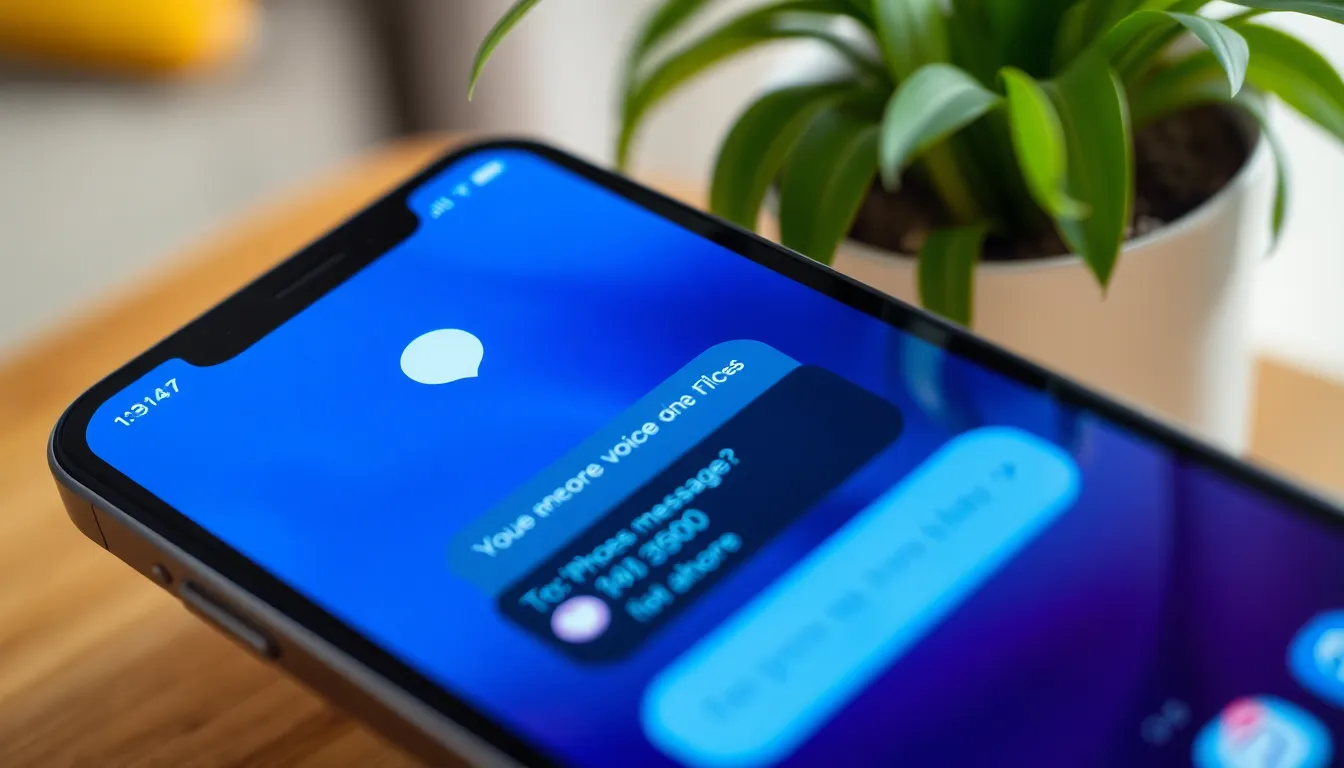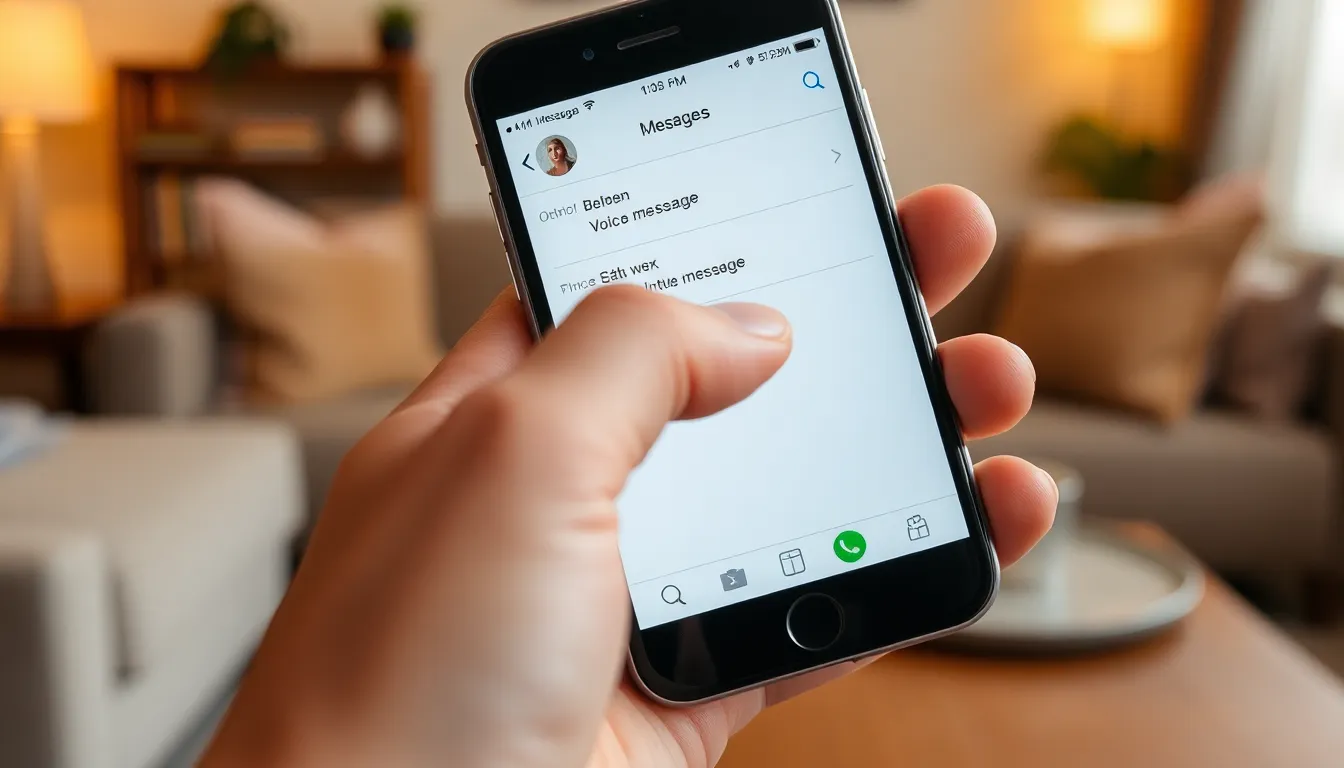In a world where fleeting moments vanish faster than a Snapchat, keeping voice messages on an iPhone can feel like trying to catch smoke with your bare hands. Those golden nuggets of audio wisdom—whether it’s your friend’s hilarious rant or a heartfelt message from a loved one—deserve to be preserved. After all, who wouldn’t want to relive that time your buddy accidentally sang the wrong lyrics to their favorite song?
Table of Contents
ToggleUnderstanding Voice Messages on iPhone
Voice messages on iPhone serve as a convenient means of communication, allowing users to send audio recordings instead of traditional text. These messages capture various aspects of conversations, including emotions, tones, and nuances that text cannot convey.
Users typically access voice messages through the Messages app, where they appear in chats as small audio files. Some prefer voice messages for their immediacy and personal touch, making them ideal for quick updates or heartfelt messages.
Storing voice messages proves essential for many. These audio clips may hold sentimental value, representing cherished moments that users want to revisit. Saved messages can remind listeners of significant events, providing a more profound connection than written messages.
Managing voice messages presents some challenges. Once a message gets listened to, it often disappears unless it is explicitly saved. Although iPhones do not have a built-in feature to permanently store these audio files, users can employ various techniques to preserve them.
Sharing voice messages with email or third-party apps helps keep them safe. Users can send the message as an attachment, ensuring a backup exists for future reference. Furthermore, transferring files to cloud storage services maintains accessibility.
Audiobook features or voice memo applications may also serve as alternatives for maintaining voice messages. Recording and storing them elsewhere keep memorable messages intact. Various tools are available, allowing users to choose the method that best suits their preferences.
Utilizing these strategies offers practical solutions for preserving voice messages on iPhone. Users can experience peace of mind knowing they can rekindle connections through voices from the past.
Ways to Keep Voice Messages

Finding ways to retain voice messages on an iPhone enhances their accessibility and sentimental value. Employing different methods helps ensure users preserve their favorite audio snippets.
Saving Voice Messages in Messages App
Voice messages can easily be saved within the Messages app. Long-press the voice message, then tap “More.” A selection of options appears; choose the “Save” option. This stores the message in the voice memos section of the user’s iPhone. Organizing messages into specific conversations ensures quicker retrieval in the future. Additional options like forwarding via email or saving to a cloud service enhance flexibility and accessibility.
Using Third-Party Apps
Several third-party apps offer effective solutions for preserving voice messages. Apps designed for audio recording or file management help save and manage audio clips seamlessly. Users can download applications like WhatsApp or Dropbox for extra features, such as direct saving of voice messages. Importing audio files into these apps helps maintain organization and easy access. Different apps provide unique functionalities, catering to diverse user preferences and ensuring the voice messages remain intact.
Managing Your Voice Messages
Managing voice messages on an iPhone requires a few steps to ensure users preserve their favorite clips. Effective management helps maintain access to these meaningful recordings.
Deleting Unwanted Messages
Deleting unwanted messages provides clarity in the voice message section. Users can easily swipe left on a voice message within the Messages app and tap “Delete.” This action removes clutter, making it simpler to find cherished audio clips. Regularly clearing out unnecessary messages enhances organization, ensuring essential messages don’t get overlooked.
Organizing Saved Messages
Organizing saved messages promotes efficient retrieval. Users can create themed conversations or designate specific contacts for voice messages. Utilizing the voice memos app allows individuals to categorize recordings based on topics or events. Labels or notes can help identify the context of messages, simplifying future searches. By structuring saved messages accordingly, users always find their cherished audio from friends and family with ease.
Troubleshooting Common Issues
Users often encounter challenges when trying to keep voice messages on their iPhones. Missing saved messages can lead to frustration. Ensure the Messages app is updated to the latest version, as updates can fix bugs or glitches that affect functionality.
Sometimes, message播放 issues arise. Restarting the iPhone can resolve playback problems. Doing this often refreshes the settings and clears temporary glitches.
Storage limitations may also affect voice message retention. Checking available space on the device helps identify if storage is the issue. When storage is low, deleting unnecessary files can open up space for new voice messages.
Accessibility problems can occur when trying to find saved messages. Users should navigate to the Voice Memos app to check if messages were saved there. Familiarizing with the app layout can ease the search process.
Occasionally, third-party apps interfere with message saving. If using applications like Dropbox or WhatsApp, ensure that they are properly linked to the device. Verifying app permissions may help retain audio files.
Lastly, understanding the message expiration settings is important. Some settings automatically delete messages after a set time. Reviewing and adjusting these settings ensures users keep crucial voice messages longer.
By following these tips, addressing common issues with voice messages on iPhones becomes manageable.
Preserving voice messages on an iPhone is crucial for maintaining those special connections. With the right techniques users can ensure that these cherished audio clips remain accessible. Whether through the Messages app or utilizing third-party solutions it’s possible to keep those heartfelt or humorous recordings alive.
Regularly organizing and managing these messages not only reduces clutter but also enhances the overall experience. By staying proactive in saving important voice messages and troubleshooting common issues users can enjoy their iPhone’s capabilities to the fullest. With a little effort anyone can turn fleeting audio moments into lasting memories.






